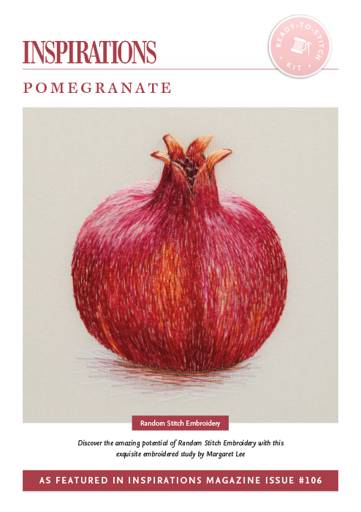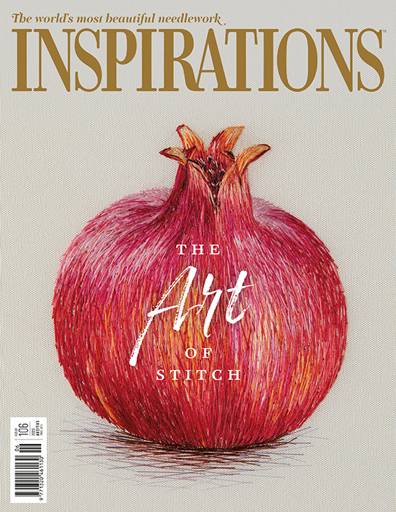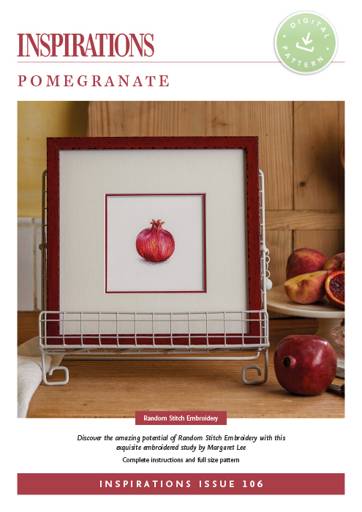Pomegranate by Margaret Lee
1ST MAY 2020 - ASU #232
Adorning the cover of Inspirations magazine #106 is a deceptively simple still life of a pomegranate.

Sitting alone on a plain ground, the texture and accuracy of the piece is striking. It is clear to see Margaret Lee’s precise and skilled hand in this design.

This is a project which provides the perfect introduction to the technique of random stitch embroidery, discussed in previous newsletters and introduced in her new book, The Art of Chinese Embroidery 2 | Intermediate Level.

In order for us to best convey the nuances of this project, we decided to seek out the expert and caught up for a chat with Margaret herself. We felt that no-one could provide enlightenment on both the subject matter and the technique like she can.
We asked her initially about the pomegranate itself. It’s such a unique fruit, we were curious about its significance. Margaret told us that in China, the pomegranate has long held significance in both cultural practice and the arts.

‘…depending on the occasion and regional beliefs, the pomegranate symbolizes fertility and plenty, filial piety, a happy union between couples and a close bond within the family unit and between friends.
The perfect form of the flower of the plant and its colour also symbolise feminine beauty.’
Representations of the pomegranate are used in wedding ceremonies, bridal chambers and on purses as a symbol of affection. And the actual fruits are used as gifts and decorations for good luck.

This is an incredibly appropriate image to stitch during these troubled times. Which brings us to the stitching itself. So many people look at a project like this and immediately fear that they won’t be able to achieve it. So, Margaret offered some wonderful advice to the new stitcher.

Initially, she emphasized that you need to approach your embroidery as art, not as embroidery.
‘The needle and thread are your brush and paint, and technique is technique whether you wield a brush or a needle.’
Before starting on your actual piece, set up a ‘doodle frame’ to practise the techniques. When you first start out, use a thicker thread like broder cotton to familiarise yourself with the technical stitching requirements until you are comfortable.

Margaret encourages learning by copying the images and diagrams provided, and suggests that the basics, which are outlined in her first book The Art of Chinese Embroidery 1 | Foundation Level, should be mastered first. However, she was quick to point out,
‘…mastery of the art is a stepped, developmental process underpinned by practise and patience.’

In summary, Margaret offered some wonderful words:
‘Be brave.’
‘My students often hear these two words from me. You will be amazed how the colours and stitches will merge and transform. A famous Chinese quotation translates as: ‘Order exists in random’ and this is so for random stitch embroidery. At first glance, the stitches appear randomly placed but that is not the case.

Each stitch and its colour is thoughtfully considered, such that they merge into an orderly structure to create colour and form.’
It is the right moment to be brave, give yourself time and space, and let yourself go. You’ll be amazed at what you can produce.

Make Your Own | Pomegranate

Step 1 – Purchase Project Instructions
Pomegranate by Margaret Lee is an exquisite embroidered study.
Step 2 – Purchase Ready-To-Stitch Kit
The Inspirations Ready-To-Stitch kit for Pomegranate includes everything* you need to re-create this lifelike study: Pre-printed fabric, lacing thread, embroidery threads and needles.



